Assignment 1
Exploring Sound Qualities in Architectural Design
1) Mouth of the Whale (Capolago, CH).
The main purpose of the pedestrian tunnel called “Bocca della Balena” by the residents of the village of Capolago is to allow a pedestrian passage from the mountain road going up the Generoso Mountain to the new driveway built under the highway. What makes this space very special is the echo and reverberation that is generated by the geometry of the material used to make the internal covering. The shape of the roof is vaulted and the covering was made of corrugated metal elements typical of shed roofs. What is very attractive about this space is its staircase that, upon entering the tunnel, leads to a completely dark space. The shape also very much resembles the palate of a whale, which is why it got this name. What happens inside this tunnel are the following things: Reverberation, for the bouncing of waves emitted on all the walls; Echo, for the return of sound from previously emitted waves; and a particular delay in the reception of sounds if the listener is at one entrance and sounds are produced from the opposite entrance. I have experienced this space since childhood and it has always seemed to me to be a magical space both visually and audibly. Inside, since it is not lit, one can only glimpse the edges of the steps illuminated by natural sunlight, and because of this one has the feeling of being inside a movie set.
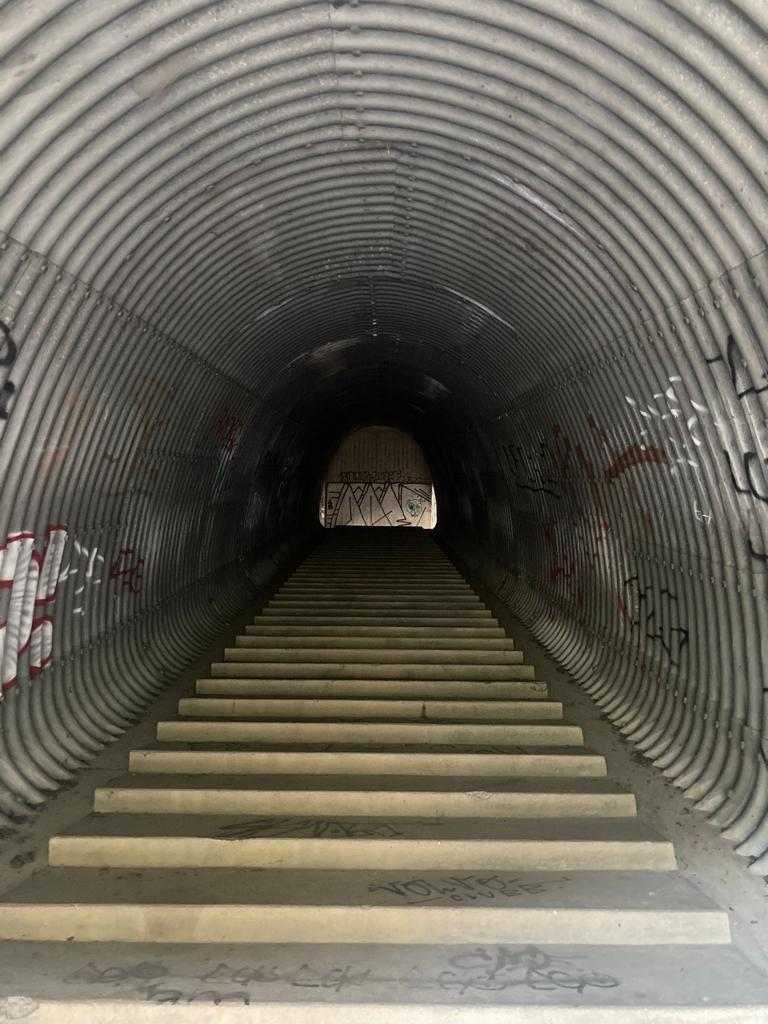
2) Ruta de los Hospitales (Asturias, ES)
This is an open space that runs along a 24.1-kilometer route starting from Borres and arriving towards Berducedo, Spain. The main purpose of this place is to allow pilgrims on the Pilgrim’s Way to Santiago to traverse the mountain peaks that separate the two localities of Borres and Berducedo, offering a unique experience. What makes this place special for acoustics is the fact that, in Asturias, it is always very cloudy. Going up the mountains I had found a lot of fog and since I was traveling this route with my girlfriend, at one point because of the fog we could not hear each other even though we were screaming. Whereas the moment we reached the peaks and overcame the fog, I had the impression that we could scream from one mountaintop to the other and hear each other very well. So, although the place was the same, through a change of air density, the way of sound propagation also changed. What attracts the attention of this place is its general atmosphere: the Asturian mountains had a major fire a few months before my passage, and the fact that even acoustically we could not hear each other a few dozen meters away made this place very special. What we could hear very well was the dull sound of footsteps on the scorched earth. In addition to this, there was a constant sound of rain, even though it had never rained the whole way, because the moisture accumulated on the branches of the burned trees and then fell in the form of drops, so even if it wasn’t raining, audibly it sounded like rain.
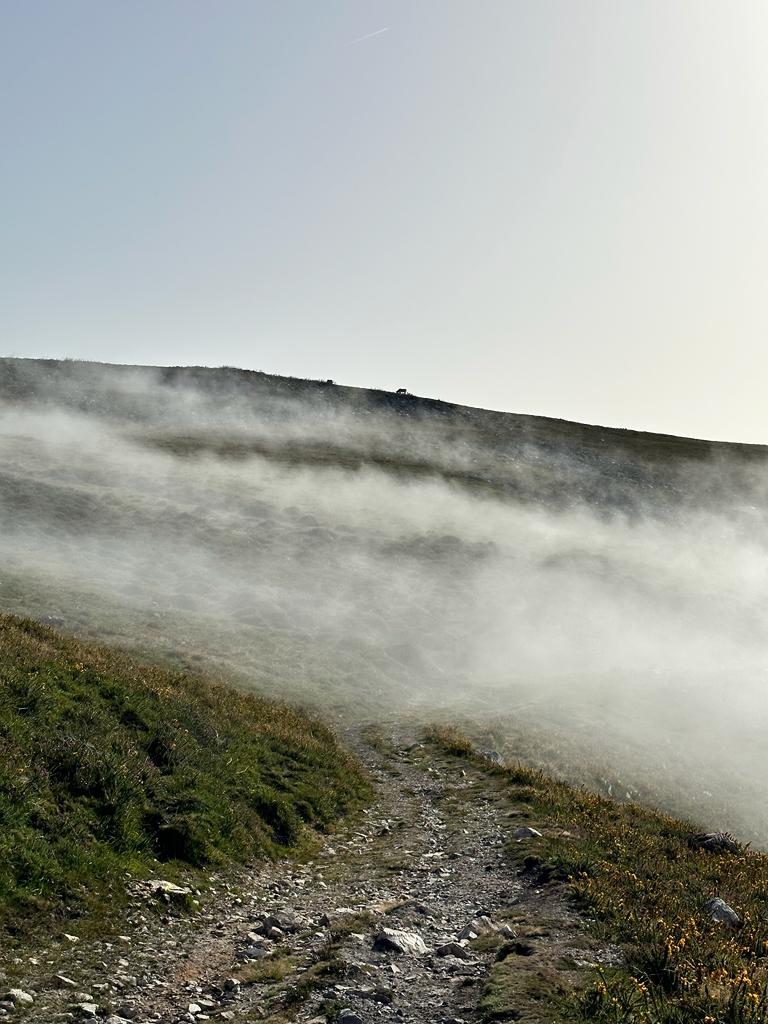
3) Auditorium Room E1 at ETH Zürich (Zürich, CH).
The main purpose of this room is to allow all its zones to receive the same amount and power of sound as it is used as an Auditorium room for a large number of people. What makes this space special is its perimeter conformation and its ceiling: the irregular surfaces allow sound to bounce off specific points that allow everyone to hear the sound produced by the source with the same intensity. The sound of the environment is what attracts the most attention, as it is the entirety of the space that allows it to function. What amazes me at most is the absence of reverberation or echoes that are unfortunately present in so many auditorium classrooms in which I have been in the past.

Assignment 2
Exploring the Emotional Impact of Everyday Sounds
A motorbike ride
The sound I would like to present in this research is the noise produced by my motorbike, a Harley Davidson Sportster.
Two weeks ago I had decided to travel from my home in Ticino to Zurich to take advantage of the fact that a light vehicle like a motorbike could be useful as a means of transport in a city where public transport costs are quite high.
Unfortunately, not having done a full service to the bike in time, such as an oil change and an overhaul of the electrical system, I began to experience the first problems during the journey, and especially when using the bike in the city.
At low revs, in fact, the bike tends to shut down, and with time – and after many engine shutdowns – I realised at what pace the sound of the engine must come when I stop at a traffic light. If the rhythm of the sound slows down beyond a certain limit, then it shuts down.
Also, being a Harley Davidson, its noise produces a distinct tu-tum – tu-tum – tu-tum – …, so through its sound I can tell if the engine is running well or not.
Sometimes the rhythm of the noise decreases very quickly, in a very random way, and this conveys a certain anxiety to me, especially at the moment when I am standing in front of the traffic lights and behind me there is a line of cars ready to go.
In this sense, the excessive slowing down of the engine revs causes me anxiety and in a way they are a warning that the bike is about to turn off.
In addition, the rest of the sounds are muffled due to the fact that I am wearing a helmet, and the only sound I can hear is that of the motorcycle.
My apartment in Zürich
I live in a very small apartment, ca. 25 m2, waiting actually for my future apartment that is going to be available in mid October. This apartment, being a temporary solution, is so small that the room comprehends all the equipment that an actual house should have. That means that next to my bed I have the kitchen, that unfortunately happens to be equipped with a very loud fridge. I can hear it right in this moment, a low sound that seems like wind noise going through a high staircase room. It is actually the first time I hear it, because normally I am concentrated in doing so many things that I never stop to hear how this room sounds like. I hear a continuous “whooooooooo…” noise that is a mixture of two sounds: one that stays the same, the lower one, and one that is going through a kind of circular motion with a kind of rhythm. The problem of those background noises is that, when I notice them, I can hear them all the time, and that can be frustrating and annoying at times. There are other noises as well, right now I can hear someone talking and going out of the building through the very noisy glass main door, or someone else just parking his car next to my window. Right now I’m lying on my bed, wondering after three weeks that I have lived here, if I should turn off the fridge or not.
Assignment 3
Empirical and numerical estimation of room acoustic properties
Task 1
Space 1
The space choosen for the clapping recording is a 6 meters long hallway that is 1.5 meters wide.
The hallway is caracterized by some narrow and long furnishing on the right side that do stop some waves to reach the end of the space.
The reverberation time RT60 recorded is the following:
50dB to 20dB -> 30 dB total
the total time of the decay from 50dB to 20dB is 0.32 sec, so the reverberation time is: RT60 = 0.32 * 2 = 0.64 sec
As we can see in the screenshot, there are echoes visible at the end of the graph as discreet late peaks that decrease in frequency with time

Under here we can see a photo of the space where the recording took place:
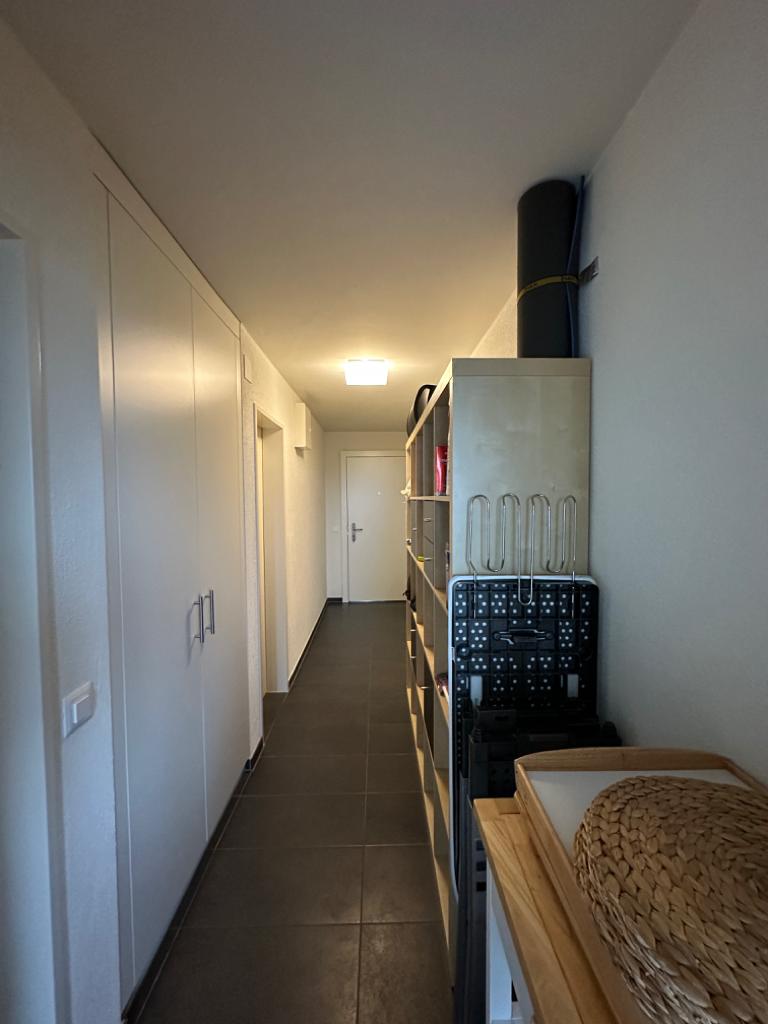
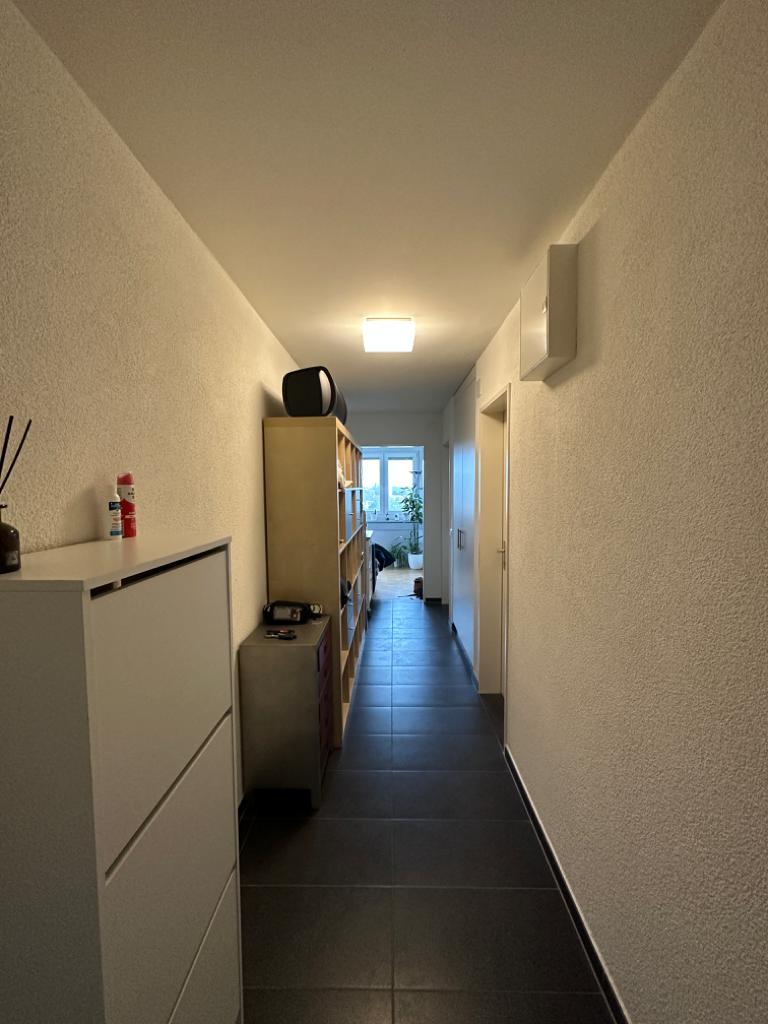
Space 2
The space choosen for the clapping recording is a 2 x 2 m large bathroom.
This space is caracterized by some elements that are able to absorb sound, like towels, and others that can reflect easily the sound waves, like the tiles on the floor and walls.
The reverberation time RT60 recorded is the following:
40dB to 10dB -> 30 dB total
the total time of the decay from 40dB to 10dB is 0.20 sec, so the reverberation time is: RT60 = 0.20 * 2 = 0.40 sec
This time there aremn’t particular waves that are indicating particular echoes, but maybe the size of the room makes echoes arriving at the microphone much quicker than the previous test, and for that reason the small wave peaks are not so distant between each other in the graph.

Under here we can see a photo of the space where the recording took place:

Just to make another experiment, I tried to test the sound when the curtain of the baththub is fully closed, to see how different the results can be.
Those are the results I got:
40dB to 10dB -> 30 dB total
the total time of the decay from 40dB to 10dB is 0.32 sec, so the reverberation time is: RT60 = 0.32 * 2 = 0.64 sec
With just a closed curtain in a 2 x 2 m bathroom, I could create the same reverberation time as in a 6 x 1.5 m hallway.


Task 2
Through the online calculator I can estimate the reverberation time at 500 and 1000 Hz by using the online calculator on Sengpiel’s websites.
The results are the followings:
Test 1)
Test 2)
Test 3)
Assignment 4
Characterization of room acoustic treatments
I’ve choosen to take a closer look at the hallway of my apartment in Zürich that I have already tested in the previous assignment.
By looking at the space I can say that almost the entire wall on the right has some type of absorbtion capacity thanks to the furniture that can stop some waves to propagate through the hallway. Those elements are maximum 40 cm deep and can vary in lenght and height. The material of which they are made of is mostly wood so absorbtion is still low compared to other materials. What is helping is their design, that can allow sound waves to be deflected in smaller areas and get trapped. I think that the absorbtion properties can be strong for mid-frequencies.
The tipology of furnishing that can allow a diffuse reflection of sound are the ones that have flat and smooth surfaces and in this space the only continuous flat and smoot surface is the flooring. In fact thanks to the tiles, the floor can be highly sound-reflecting.
The room is an extended parallel that finishes with a smooth panel (the door), and this geometry can let sound be reflected various times until it reaches the door. Then the door itself can be a reflective element and can send some wave sounds back to create echoes in the space.
The absorbers are all positiones on the right side of the room and are alligned on the wall until almost the end of the hallway. I would say that the positioning of the furnitures allows only a good passage for people, but this is still not the best arrangment when we talk about sound quality, because sound is still reflected quite a lot.
Acoustis measures were clearly not taken into consideration during the process of construction, because the material used are all linear and smooth. Moreover, the whole hallway was designed to be eventually completely closed by doors, and this can create an acustically low quality space because there would be a constant strong reverberation.

Assignment 5 (group work)
Sound making – Sound walking
Part 1: Sound making
The object chosen for this research is an angle grinder. The reason for choosing this object is to understand the power of sound that a common construction object such as an angle grinder can generate.
On construction sites, machines that produce very high decibels are used every day, and in the long run there could be auditory consequences for workers.
The object was recorded in an open space in the absence of elements that can reflect the emitted sound waves. The space features a street between two tall industrial buildings, but the width of the street itself allows for almost no reverberation of the emitted sound waves.
The Angle Grinder is a construction tool that is used to cut elements with considerable density, thanks to the application of specific blades for the job.
The sound produced is therefore a very loud sound, since the motor that turns the blade must be extremely high-performance. The noise emitted rises in decibels very quickly and no longer increases as soon as the maximum speed is reached. The peculiarity of this object is that by itself it generates a loud and constant sound but, in the moment the blade comes into contact with an item to be cut, the sound increases in intensity and changes depending on the following factors: the blade used, the object to be cut, and the pressure used in cutting.
Part 2: Sound walking
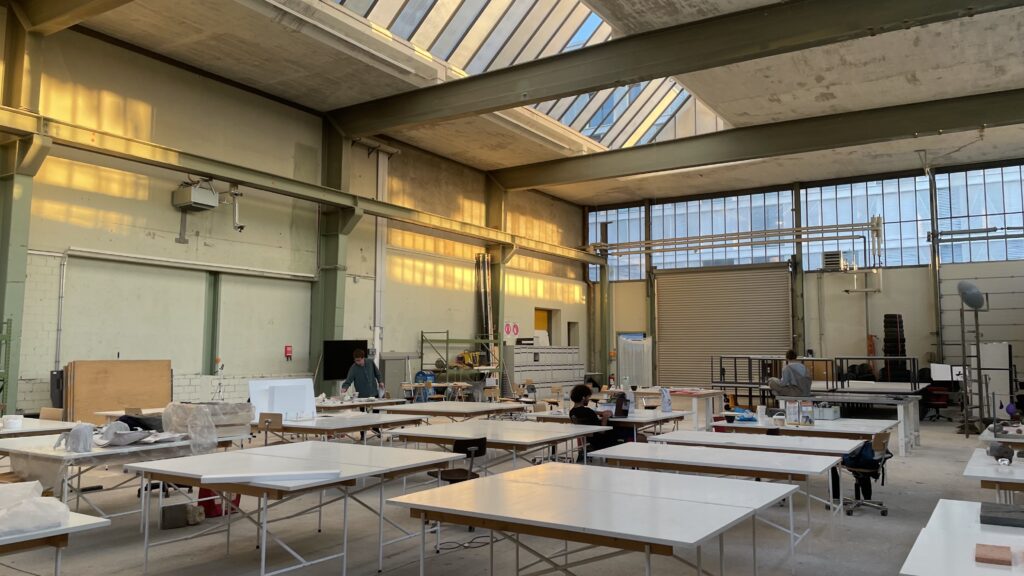
Our soundwalk analyses the different sounds that characterise 2 different environments. The first half of the recording is registering the sound sources of an outer space. Some steps on asphalt in a large street between 2 high buildings were recorded.
After that we reach the door that separates the outdoor space from the indoor space. Inside we can hear a lot of reverberation as the interior of the building is almost empty and the flat concrete and glass surfaces reflect many soundwaves.
The sound of a coffee machine is then recorded in the last piece of the registration. The mechanical sound symbolises the start of a working day.



